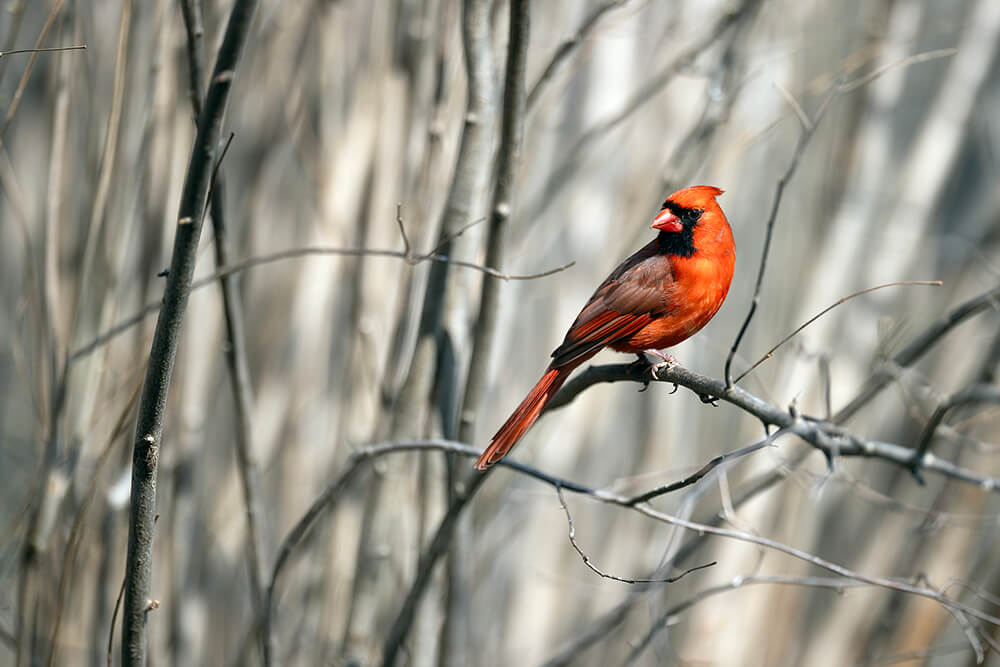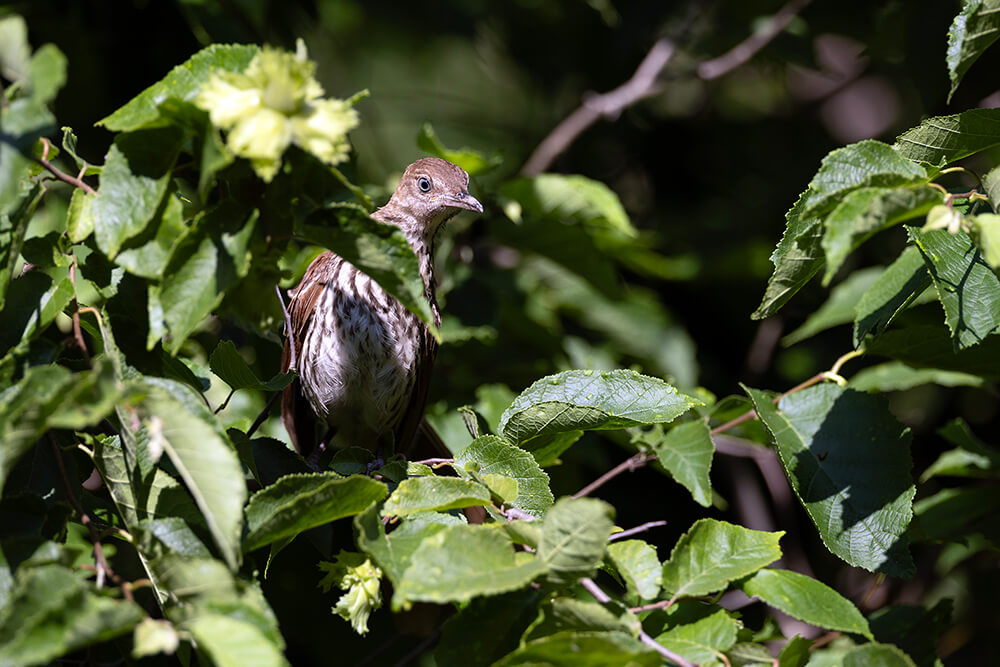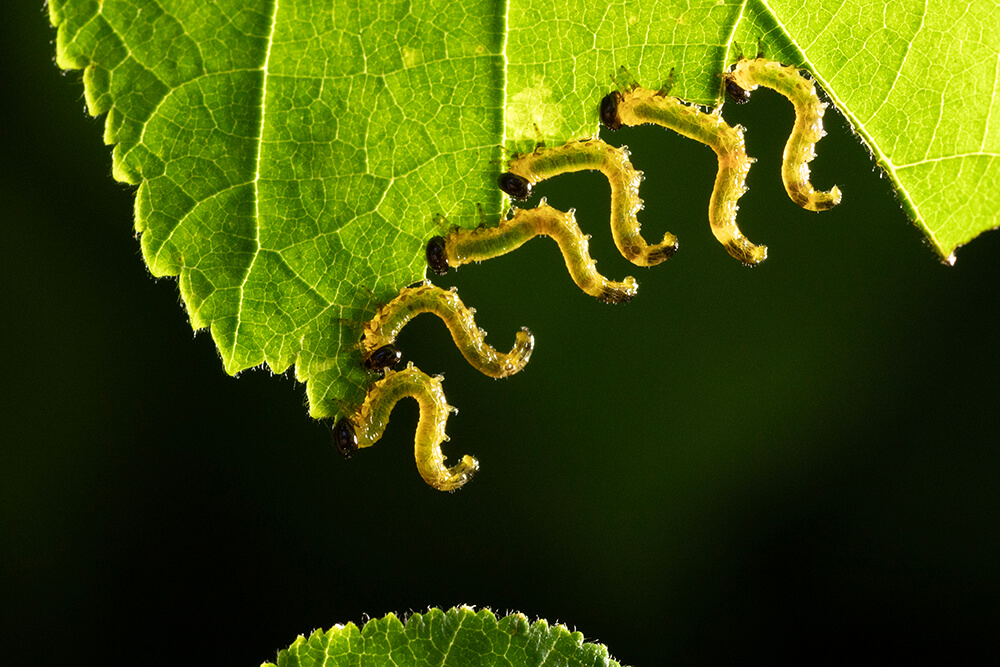American Hazelnut:
"My Favorite Shrub"
There are gobs of native plant species that I eagerly recommend to fellow wildlife gardeners. But there aren’t many that cause me to enthusiastically proclaim, “It’s my favorite!,” especially in the shrub category. So far, I’ve planted viburnums, chokeberries, dogwoods… and while all are terrific plants, they don’t quite rate that “favorite” designation.
The woody plant that I do find exceptional? Our American hazelnut (Corylus americana). It’s one of the more beloved native shrubs on my property because it feeds my gray squirrel friends and because it’s adaptable to a wide range of growing conditions. And I mustn’t forget its four season interest!

The "Missing Middle"
Our gardens are in need of various plant heights and the tall, leafy native shrub is often a missing component. These larger shrubs provide food and cover and are therefore important for supporting all kinds of animals.
American hazelnut is commonly referenced as a large shrub or small tree, growing up to 12 feet tall and just as wide. It’s not for small spaces. The prominent hazelnut in my back habitat, situated in a sunny spot, has grown over the years (perhaps ten years) to about its maximum dimensions and is now a dense joyous thicket. The other hazelnut I planted, in the shade of a red maple, neither produces the same lush foliage nor does it produce fruit like the one in full sun does—even though I’ve seen it flower. But it’s fairly tall and broad—and it appears to be healthy.

I'm a sucker for this plant!
One attribute that may or may not appeal to gardeners is this deciduous shrub’s propensity to send up auxiliary stems; with sun exposure, it suckers freely and expands its footprint. For my wildlife-sustaining purposes, this is a favorable trait!

The hazelnut’s many stems provide excellent flee-the-predator protection for birds, even in the winter when the leaves have dropped. And after the shrub has leafed out in early summer, it can provide good nesting habitat, although I’ve only had a few birds attempt a nest—the latest a pair of brown thrashers—but a heavy storm jostled the twiggy nest a bit and then the squirrels who were gathering the hazelnut fruit further disturbed it. Perhaps some other year?

Deer Shrub, How Do I Love Thee?
There are white-tailed deer that regularly roam through my habitat and while they browse a variety of plants, they seem to be partial to hazelnut. Naturally, I welcome them to munch on the bounty of leaves and arching stems. They help to keep the perimeter of the plant trimmed!

In the early winter, the bucks in rut flog the living daylights out of the multi-stems—perhaps to leave a scented love note to potential mates. A few broken stems have not deterred the growth of this hardy plant.
Most important to me, my large shrub produces an abundance of hazelnut fruits; ruffled green nuts that will never get a chance to ripen in my squirrel-laden landscape.

The Adirondack Almanack has this factoid about fruit production: “When used in landscaping, there seems to be some confusion over whether or not you need more than one hazelnut to get nuts. Since hazelnuts are monecious (have both male and female flowers on the same plant) and are pollinated by the wind, they are self-fertile. This means you don’t need more than one plant to get nuts. However, it appears that pollination might sometimes be weak, and they often seem to benefit from multiple shrubs in order to increase pollination and fruit set. So, if you have the space, it seems your best bet is to plant a few to be on the safe side.”
Perhaps your good neighbor has room for one, too?

Here you can see the elongated male catkins and the red female flower clusters in late winter.

Who Else Eats Hazelnut?
For those of us who keep track of host plant/Lepidoptera counts, American hazelnut is definitely notable. The leaves can be consumed by 124 moth and butterfly species. Not too shabby! The foliage of the hazelnut also feeds other animals like leafhoppers and beetles. I can tell from all the teeny nibbles that the plant has a large insect fan base.

(The camouflaged caterpillar's frass (poop) gave its location away.)

Sawflies are a group of insects related to wasps; the larvae eat a variety of plants.
Most of us could plant American hazelnut in our gardens given how agreeable it is to various conditions. Dry, shady, moist, sunny… once it’s established, it doesn’t need to be fussed over. Vaplantatlas.org gives this habitat information for the state of Virginia: “Mesic to dry upland forests, well-drained floodplain forests, rocky woodlands, and old fields.” That’s a lot of different growing conditions!
Let's Do a Quick Recap
Here’s why I’m a fan of American hazelnut:
→ Fairly fast growing
→ It’s happy in a variety of soil and light conditions
→ Can make a good, dense cover for wildlife
→ Mature size is essential and missing in many residential landscapes
→ Fruit is food for mammals and birds
→ Host to at least 124 moth and butterfly caterpillars; numerous other insects will eat the foliage
→ Attractive arching habit
→ Four season interest including pretty fall color

use American hazelnut as cover.
As always, if you can purchase local ecotype material (plants grown from seed or cuttings that have been collected in your region’s natural areas) it’s the best of the best. If hazelnut is not native to your area, plant something else that will fill the missing middle. Let’s start thinking in terms of what Ma Nature does and replicate that in our gardens, and everything else good will follow.
American Hazelnut Resources:
Maryland Biodiversity Project: https://www.marylandbiodiversity.com/view/1353
North Carolina State Extension: https://plants.ces.ncsu.edu/plants/corylus-americana/
